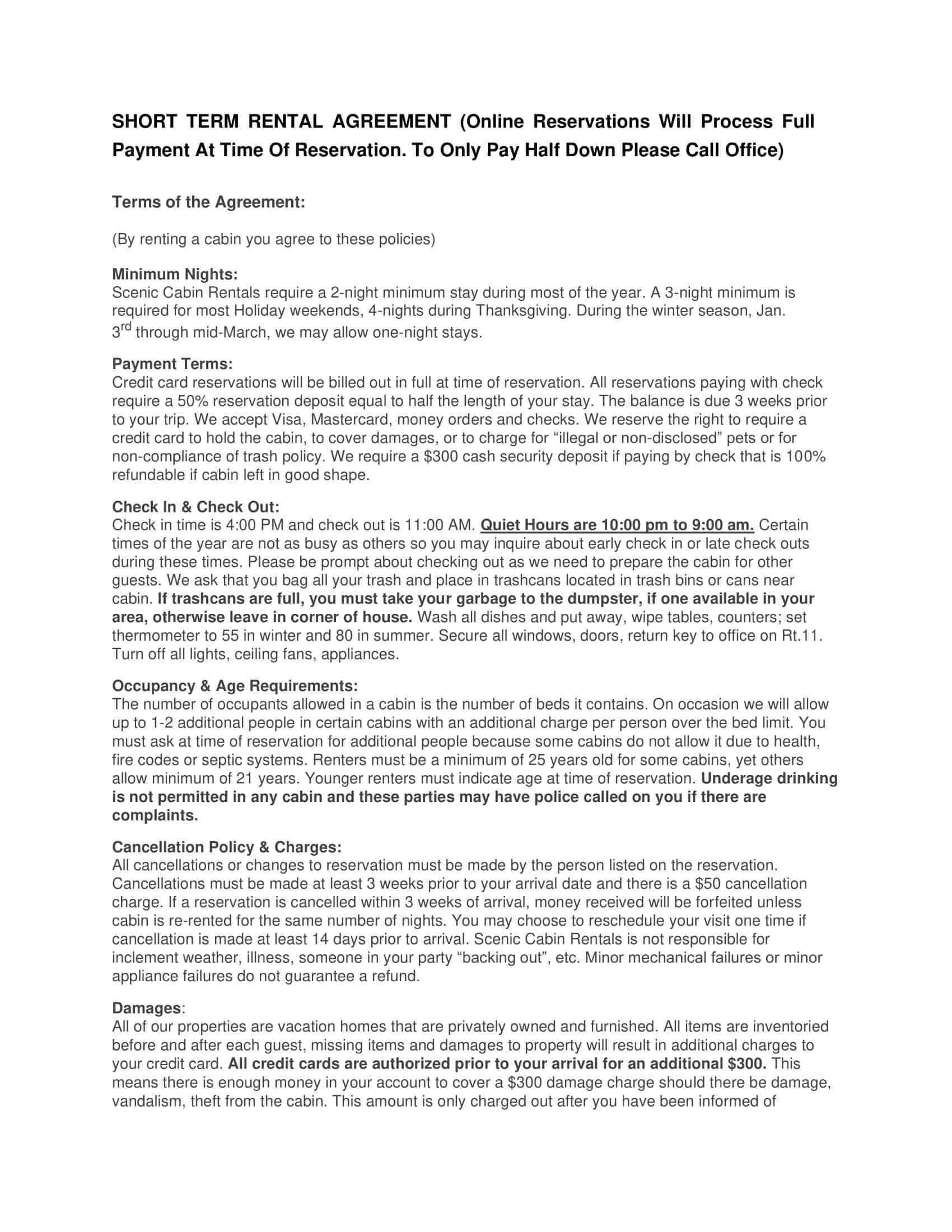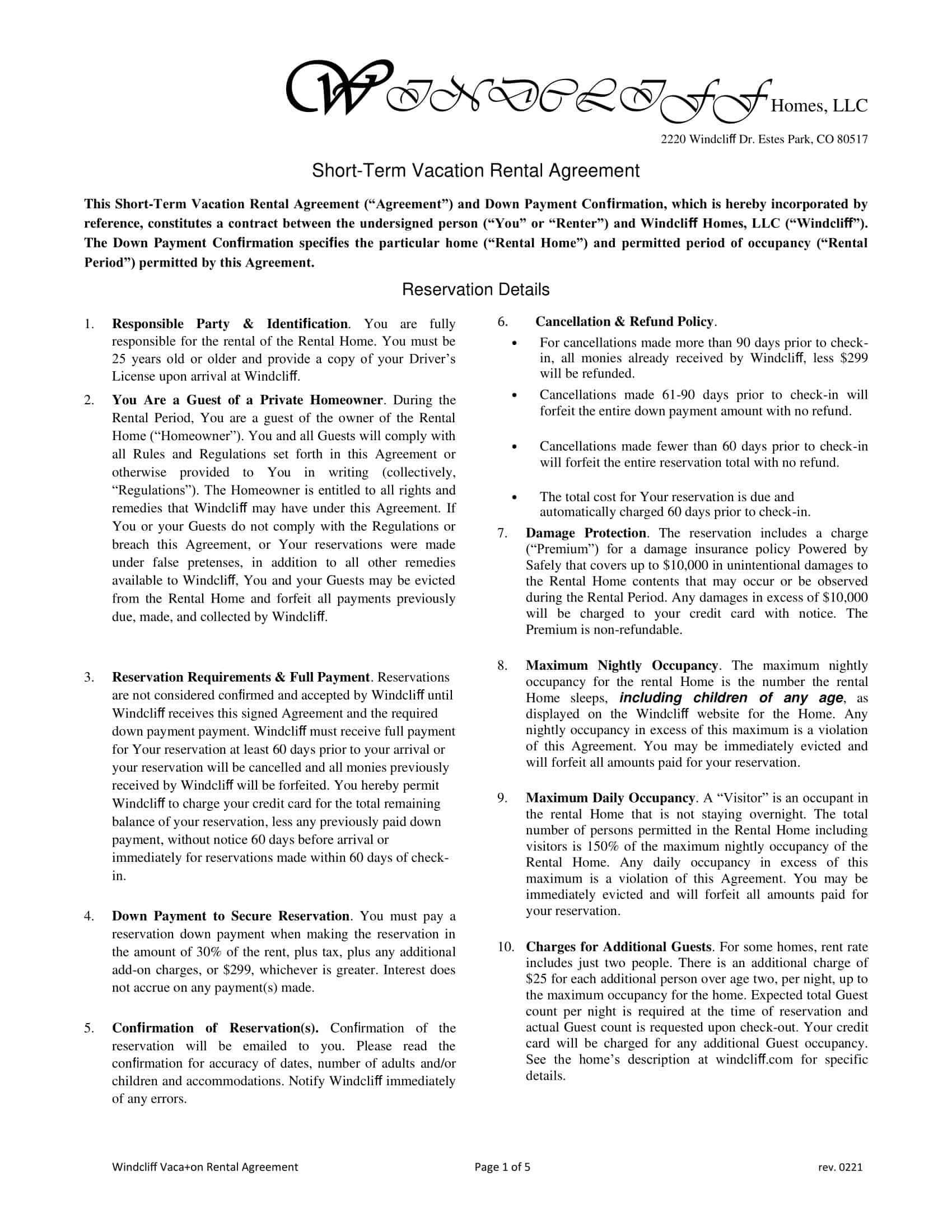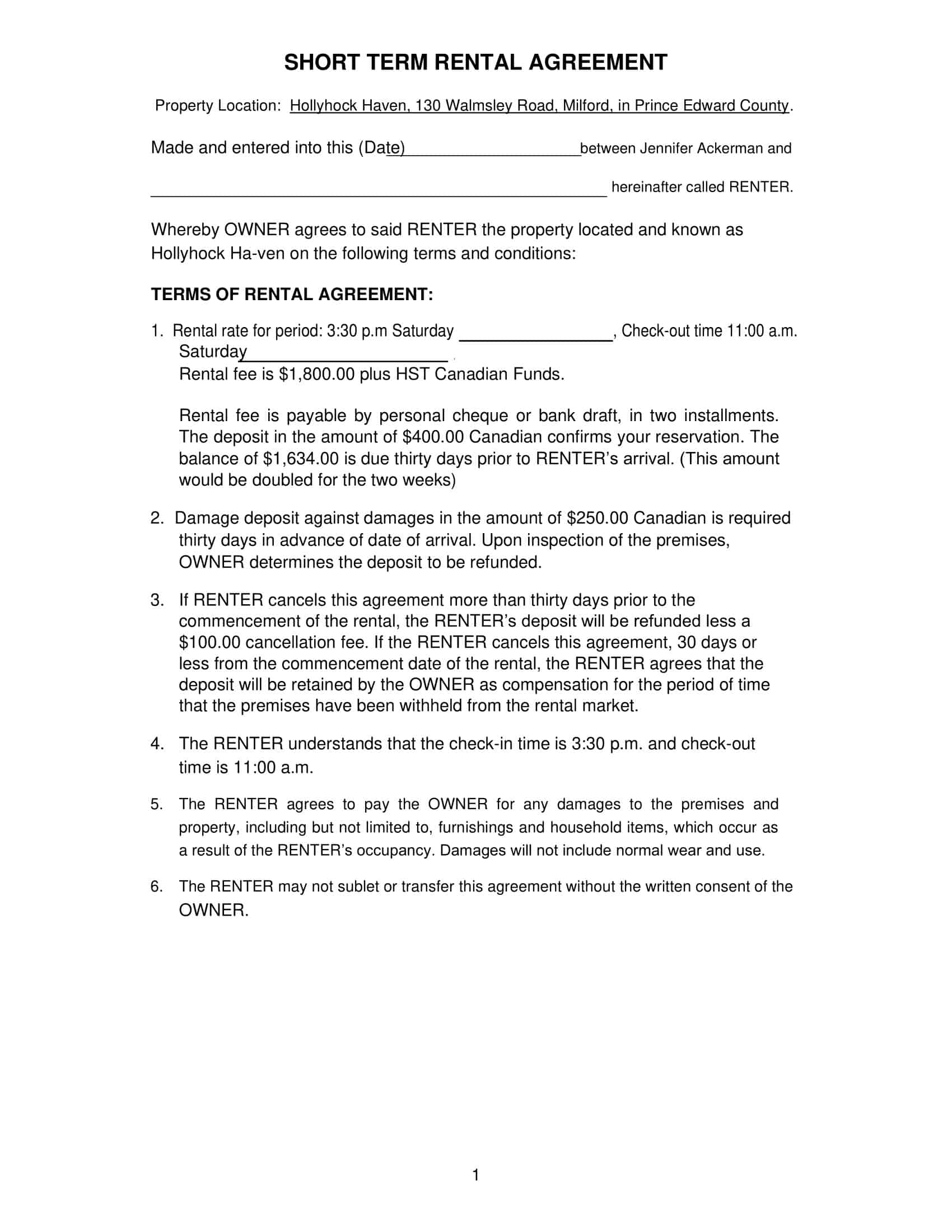Short-term rental agreements have become increasingly popular in recent years, with the rise of vacation rental platforms such as Airbnb and VRBO. These agreements allow property owners to rent out their homes or apartments for a short period of time, often to travelers or tourists.
While short-term rentals can be a lucrative source of income, they also require a well-written and clear rental agreement to protect both the landlord and the renter. In this article, we will explore the key components of a short-term rental agreement, as well as the legal and practical considerations that landlords and renters should keep in mind when entering into this type of arrangement.
Table of Contents
Short-Term Rental Agreement Templates
Short Term Rental Agreement Templates are comprehensive and standardized documents used to establish legally binding agreements between property owners or hosts and individuals or entities seeking short-term accommodations. These templates provide a structured format for outlining the terms and conditions of the rental arrangement, ensuring clarity, and protecting the rights and responsibilities of both parties. Short Term Rental Agreement Templates are commonly used in the vacation rental industry, allowing property owners to rent out their spaces for a limited duration, typically ranging from a few days to a few months.
Short Term Rental Agreement Templates provide a standardized and reliable approach to renting out properties for short-term stays. By utilizing these templates, property owners and tenants can establish clear expectations, protect their interests, and ensure a smooth and mutually beneficial rental experience. Whether used by individual property owners, vacation rental platforms, or property management companies, Short Term Rental Agreement Templates serve as a valuable tool for facilitating rental transactions and establishing legally enforceable agreements.
What is a Short-Term Rental Agreement?

A Short-Term Rental Agreement is a legally binding contract between a landlord or property owner and a renter for a rental period typically ranging from a few days to several weeks. Short-term rentals are commonly used for vacation or business travel, and the agreement outlines the terms and conditions of the rental, including the rent amount, payment terms, security deposit, check-in and check-out dates, and any other specific rules or regulations that both the landlord and the renter must follow. The agreement can also address issues such as liability, insurance, and maintenance responsibilities.
Short-term rental agreements can provide a flexible and convenient option for renters, but it is important for both parties to fully understand the terms of the agreement and ensure that they are legally binding and enforceable.
Who Needs a Short-Term Rental Agreement?
A Short-Term Rental Agreement is typically needed by any landlord or property owner who wishes to rent out their property on a short-term basis, whether it’s a room, an apartment, or a whole house. This includes individuals who want to rent out their primary residence while they are away on vacation or business, as well as property owners who specialize in vacation rentals or short-term corporate housing.
Similarly, renters who are looking to rent a property for a short-term period, such as vacationers or business travelers, should also require a Short-Term Rental Agreement to protect their interests and clarify the terms of the rental.
In either case, having a Short-Term Rental Agreement helps to establish clear expectations and responsibilities for both parties, and can help prevent disputes or misunderstandings that may arise during the rental period. It’s important for both the landlord and the renter to ensure that the rental agreement is legally binding and enforceable, and to seek legal advice if necessary.
When Should You Use a Short-term Rental Agreement?
A Short-term Rental Agreement is recommended when renting out a property for a period of less than one year. This type of agreement is commonly used in situations where a property owner wants to rent out their property on a short-term basis to vacationers, business travelers, or anyone else in need of temporary housing.
Short-term rental agreements are especially useful when renting out furnished properties, as they help to establish the terms and conditions for the use of the property and its contents. The agreement can specify the rent amount, payment terms, the length of the rental period, and any rules or restrictions that apply during the rental period.
Key Things to Include in Your Short Term Lease Agreement
When creating a Short-Term Rental Agreement, there are several key items that should be included to protect the interests of both the landlord and the renter. Here are some of the most important elements that should be included in a Short-Term Rental Agreement:
Names of the parties involved: This should include the names of the landlord, the renter, and any other individuals who will be staying in the property.
Rental dates: The agreement should specify the exact dates of the rental period, including the check-in and check-out dates.
Rent amount: The agreement should specify the total amount of rent that will be paid, as well as the payment schedule.
Security deposit: The agreement should specify the amount of the security deposit required, as well as any conditions for its refund.
House rules: This section should outline the rules and regulations that the renter must follow during their stay, such as noise restrictions, smoking policies, or restrictions on pets.
Maintenance and repairs: The agreement should specify the responsibilities of the landlord and the renter with regard to maintenance and repairs of the property.
Liability and insurance: The agreement should address issues of liability and insurance coverage, and should specify who is responsible for any damages that may occur during the rental period.
Termination of agreement: The agreement should outline the circumstances under which the agreement may be terminated, such as a violation of house rules or failure to pay rent.
Signatures: Both the landlord and the renter should sign the agreement to indicate their acceptance of the terms and conditions.
What are the Consequences of Not Using a Short-term Rental Agreement?
Not using a Short-term Rental Agreement can leave both landlords and renters vulnerable to a variety of legal and financial consequences. Here are some potential consequences of not using a Short-term Rental Agreement:
Unclear expectations: Without a Short-term Rental Agreement, both the landlord and the renter may have different expectations regarding the terms of the rental. This can lead to confusion and disputes, which may be difficult to resolve.
Lack of legal protection: A Short-term Rental Agreement provides legal protection for both parties, outlining the terms and conditions of the rental. Without an agreement, either party may be left without legal recourse if a dispute arises.
Financial risks: Without a Short-term Rental Agreement, the landlord may be at risk of not receiving rent payments or not being reimbursed for damages to the property. Conversely, the renter may be at risk of not receiving their security deposit back or being charged additional fees for damages they did not cause.
Safety and security risks: Without a Short-term Rental Agreement, the renter may not be aware of house rules, safety protocols, or emergency procedures. This could result in a dangerous situation, particularly if the property is unfamiliar to the renter.
Tax consequences: When renting out a property, landlords may be subject to taxes on their rental income. Without a Short-term Rental Agreement, landlords may not have the necessary documentation to prove their rental income, potentially resulting in fines or penalties.
Stubborn guests: In the absence of a Short-term Rental Agreement, it may be difficult to enforce house rules or remove stubborn guests who refuse to comply. This can lead to a frustrating and potentially unsafe situation for both the landlord and other renters.
Damaged property: Without a Short-term Rental Agreement, it may be challenging to hold renters responsible for damages to the property. This could result in costly repairs and maintenance expenses for the landlord.
Expensive attorney fees: If a dispute arises between the landlord and the renter, it may be necessary to seek legal counsel. Without a Short-term Rental Agreement, the legal process may be more complicated and expensive.
Not covered by Airbnb: If the Short-term Rental Agreement is not in place and the rental is done through a platform like Airbnb, the platform may not cover damages or liability issues.
How to Write a Rental Agreement for Vacation or Short-Term Stays
Writing a Rental Agreement for Vacation or Short-Term Stays requires careful consideration of many important details. It’s essential to include terms and conditions that protect both the landlord and the renter, while also ensuring that expectations are clear and any potential disputes can be resolved easily. Here’s a step-by-step guide to writing a Rental Agreement for Vacation or Short-Term Stays:
Step 1: Gather the Necessary Information
Before you begin drafting your Rental Agreement, you’ll need to gather all the necessary information. This includes the name and contact information of both the landlord and the renter, the dates of the rental, the rental rate, the security deposit, and any applicable fees. Additionally, you should consider any house rules or policies you want to include, as well as any specific details about the property that renters need to know.
Step 2: Define the Terms of the Rental
Once you have all the necessary information, it’s time to define the terms of the rental. This includes specifying the exact dates of the rental period, the total rent due, and the due date(s) for the rent payment(s). It’s also important to include any fees or charges that may be incurred, such as a cleaning fee or a fee for additional guests.
Step 3: Include House Rules and Policies
Next, you’ll want to include any house rules or policies that renters will need to abide by during their stay. This may include rules about noise levels, smoking, or pets, as well as any safety protocols or emergency procedures. By clearly outlining the rules and policies, you can prevent misunderstandings and ensure that renters know what is expected of them.
Step 4: Address Maintenance and Repairs
To prevent disputes over maintenance and repairs, it’s important to address these issues in your Rental Agreement. Specify which party is responsible for maintenance and repairs, and include any procedures for reporting maintenance issues. It’s also a good idea to outline how repairs will be paid for and whether the renter will be reimbursed for any expenses they incur.
Step 5: Address Liability and Insurance
To protect both the landlord and the renter, it’s important to address liability and insurance in the Rental Agreement. Specify who is responsible for any damages that occur during the rental period, and whether renters are required to have their own insurance. It’s also a good idea to include a hold harmless clause, which protects the landlord from any claims or lawsuits that may arise during the rental period.
Step 6: Specify Termination Details
Finally, you’ll want to specify the termination details of the Rental Agreement. This should include any circumstances under which the agreement can be terminated, such as non-payment of rent or violation of house rules. It’s also important to specify how notice of termination should be given and how any remaining rent or security deposit will be handled.
Step 7: Obtain Signatures
Once you’ve drafted your Rental Agreement, it’s important to obtain signatures from both the landlord and the renter to indicate acceptance of the terms and conditions. This can be done in person or electronically, depending on your preference.
In summary, writing a Rental Agreement for Vacation or Short-Term Stays requires careful consideration of many important details. By gathering the necessary information, defining the terms of the rental, including house rules and policies, addressing maintenance and repairs, addressing liability and insurance, specifying termination details, and obtaining signatures, you can create a solid Rental Agreement that protects both the landlord and the renter and helps prevent disputes.
FAQs
Can I use a template for my Short-Term Rental Agreement?
Yes, there are many templates available online that can be used as a starting point for your Short-Term Rental Agreement. However, it’s important to ensure that the template includes all necessary information and is customized to fit the specific details of your rental arrangement.
Do I need a lawyer to create a Short-Term Rental Agreement?
While it’s not required to have a lawyer create a Short-Term Rental Agreement, it can be helpful to have legal advice and guidance to ensure that the agreement is legally sound and protects both parties. An attorney can also help resolve any disputes that may arise during the rental period.
What should I do if the renter violates the terms of the Short-Term Rental Agreement?
If the renter violates the terms of the Short-Term Rental Agreement, it’s important to take action quickly to resolve the issue. This may involve enforcing the termination clause of the agreement or seeking legal recourse. It’s important to document any violations and take appropriate action to protect your interests as the landlord.
Can I modify a Short-Term Rental Agreement once it’s been signed?
It’s possible to modify a Short-Term Rental Agreement after it’s been signed, but any changes should be agreed upon by both the landlord and the renter in writing. Both parties should sign and date the modified agreement to ensure that everyone is aware of the changes and has agreed to them.
How long should a Short-Term Rental Agreement be?
The length of a Short-Term Rental Agreement can vary depending on the rental period. It should cover the duration of the rental period and include any relevant details, such as check-in and check-out dates and times.
Can I use a Short-Term Rental Agreement for an Airbnb rental?
Yes, a Short-Term Rental Agreement can be used for an Airbnb rental. In fact, Airbnb provides a standard rental agreement template that hosts can use. However, hosts may also choose to customize their own agreement to fit their specific rental needs.
Do Short-Term Rental Agreements vary by location?
Short-Term Rental Agreements may vary by location depending on local laws and regulations. It’s important to research and understand any local regulations that may impact short-term rentals in your area and ensure that your rental agreement complies with them.
Do I need to include a security deposit in my Short-Term Rental Agreement?
Including a security deposit in your Short-Term Rental Agreement can help protect you as the landlord in the event of damage to the rental property or other issues. The amount of the security deposit should be clearly outlined in the agreement, along with any conditions for its return at the end of the rental period.
Can I charge a cleaning fee in my Short-Term Rental Agreement?
Yes, a cleaning fee can be included in a Short-Term Rental Agreement. This fee can cover the cost of cleaning the rental property after the renter leaves and should be clearly outlined in the agreement.
What should I do if the renter doesn’t pay on time?
If the renter doesn’t pay on time, it’s important to follow the payment terms outlined in the Short-Term Rental Agreement. This may include sending a reminder or late payment notice, withholding the security deposit, or taking legal action if necessary. It’s important to document any missed payments and take appropriate action to protect your interests as the landlord.

















































































![Free Printable Roommate Agreement Templates [Word, PDF] 1 Roommate Agreement](https://www.typecalendar.com/wp-content/uploads/2023/06/Roommate-Agreement-150x150.jpg)
![Free Printable Room Rental Agreement Templates [Word & Excel] Form 2 Room Rental Agreement](https://www.typecalendar.com/wp-content/uploads/2023/05/Room-Rental-Agreement-1-150x150.jpg)
![Free Printable Payment Agreement Templates [PDF, Word] 3 Payment Agreement](https://www.typecalendar.com/wp-content/uploads/2023/05/Payment-Agreement-1-150x150.jpg)
